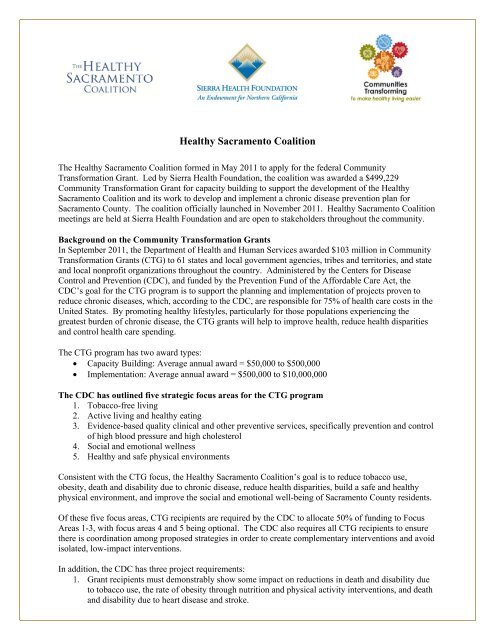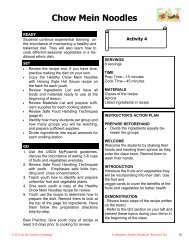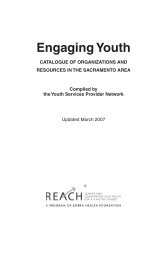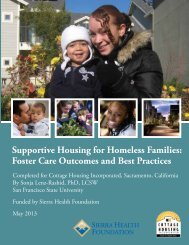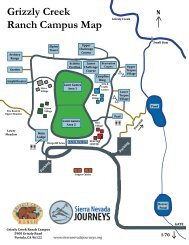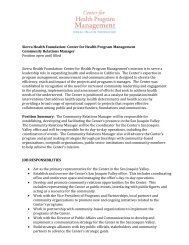Healthy Sacramento Coalition Fact Sheet (PDF). - Sierra Health ...
Healthy Sacramento Coalition Fact Sheet (PDF). - Sierra Health ...
Healthy Sacramento Coalition Fact Sheet (PDF). - Sierra Health ...
Create successful ePaper yourself
Turn your PDF publications into a flip-book with our unique Google optimized e-Paper software.
<strong><strong>Health</strong>y</strong> <strong>Sacramento</strong> <strong>Coalition</strong><br />
The <strong><strong>Health</strong>y</strong> <strong>Sacramento</strong> <strong>Coalition</strong> formed in May 2011 to apply for the federal Community<br />
Transformation Grant. Led by <strong>Sierra</strong> <strong>Health</strong> Foundation, the coalition was awarded a $499,229<br />
Community Transformation Grant for capacity building to support the development of the <strong><strong>Health</strong>y</strong><br />
<strong>Sacramento</strong> <strong>Coalition</strong> and its work to develop and implement a chronic disease prevention plan for<br />
<strong>Sacramento</strong> County. The coalition officially launched in November 2011. <strong><strong>Health</strong>y</strong> <strong>Sacramento</strong> <strong>Coalition</strong><br />
meetings are held at <strong>Sierra</strong> <strong>Health</strong> Foundation and are open to stakeholders throughout the community.<br />
Background on the Community Transformation Grants<br />
In September 2011, the Department of <strong>Health</strong> and Human Services awarded $103 million in Community<br />
Transformation Grants (CTG) to 61 states and local government agencies, tribes and territories, and state<br />
and local nonprofit organizations throughout the country. Administered by the Centers for Disease<br />
Control and Prevention (CDC), and funded by the Prevention Fund of the Affordable Care Act, the<br />
CDC’s goal for the CTG program is to support the planning and implementation of projects proven to<br />
reduce chronic diseases, which, according to the CDC, are responsible for 75% of health care costs in the<br />
United States. By promoting healthy lifestyles, particularly for those populations experiencing the<br />
greatest burden of chronic disease, the CTG grants will help to improve health, reduce health disparities<br />
and control health care spending.<br />
The CTG program has two award types:<br />
Capacity Building: Average annual award = $50,000 to $500,000<br />
Implementation: Average annual award = $500,000 to $10,000,000<br />
The CDC has outlined five strategic focus areas for the CTG program<br />
1. Tobacco-free living<br />
2. Active living and healthy eating<br />
3. Evidence-based quality clinical and other preventive services, specifically prevention and control<br />
of high blood pressure and high cholesterol<br />
4. Social and emotional wellness<br />
5. <strong><strong>Health</strong>y</strong> and safe physical environments<br />
Consistent with the CTG focus, the <strong><strong>Health</strong>y</strong> <strong>Sacramento</strong> <strong>Coalition</strong>’s goal is to reduce tobacco use,<br />
obesity, death and disability due to chronic disease, reduce health disparities, build a safe and healthy<br />
physical environment, and improve the social and emotional well-being of <strong>Sacramento</strong> County residents.<br />
Of these five focus areas, CTG recipients are required by the CDC to allocate 50% of funding to Focus<br />
Areas 1-3, with focus areas 4 and 5 being optional. The CDC also requires all CTG recipients to ensure<br />
there is coordination among proposed strategies in order to create complementary interventions and avoid<br />
isolated, low-impact interventions.<br />
In addition, the CDC has three project requirements:<br />
1. Grant recipients must demonstrably show some impact on reductions in death and disability due<br />
to tobacco use, the rate of obesity through nutrition and physical activity interventions, and death<br />
and disability due to heart disease and stroke.
2. 50% or more of implementation funding must be allocated to community entities, or<br />
governmental or non-governmental organizations.<br />
3. Efforts must be coordinated with multiple sectors, such as transportation, planning, education,<br />
health care delivery, agriculture and others.<br />
The CDC has provided some guidance on project design.<br />
First, efforts should focus on implementing policy, environmental, programmatic and infrastructure<br />
changes aligned with strategic directions to achieve changes in weight, proper nutrition, physical activity,<br />
tobacco use prevalence, emotional well-being, overall mental health and other outcomes. It defines these<br />
areas of change in the following ways:<br />
1. Policy – Educate the public and stakeholders about evidence- and practice-based policy<br />
intervention to improve population health and foster healthy behaviors.<br />
2. Environment – Create social and physical environments that support healthy living and ensure<br />
that healthy choices are the easy choice.<br />
3. Program – Increase access to prevention programs to support healthy choices and contribute to<br />
wellness, ensuring integration of their use in a variety of community and clinical settings.<br />
4. Infrastructure – Establish systems, procedures and protocols within communities, institutions<br />
and networks that support healthy behaviors, including improving linkages between public health<br />
and health care systems.<br />
Second, efforts should choose from evidence- and practice-based intervention strategies. Third, CTG<br />
recipients should include intensive strategies that target population sub-groups that would help to achieve<br />
reductions in health disparities. Finally, recipients cannot use CTG funds to support clinical care, servicedelivery,<br />
research or lobbying. CTG funding must be used for implementing policy, environmental,<br />
programmatic and/or infrastructure changes only; there is no funding for services.<br />
Learn more on the CDC web site at www.cdc.gov/communitytransformation.<br />
<strong>Coalition</strong> Next Steps for 2012<br />
▪ Build a Leadership Team<br />
▪ Build the <strong><strong>Health</strong>y</strong> <strong>Sacramento</strong> <strong>Coalition</strong><br />
▪ Complete a Community <strong>Health</strong> Assessment<br />
▪ Develop a Strategic Communications Plan<br />
▪ Begin development of a Community Transformation Implementation Plan<br />
Timeline<br />
▪ Planning Year One: September 30, 2011 – September 29, 2012<br />
▪ Planning Year Two: September 30, 2012 – September 29, 2013<br />
▪ Apply for Year Three Implementation funding in Spring 2013<br />
Learn More<br />
Visit the <strong><strong>Health</strong>y</strong> <strong>Sacramento</strong> <strong>Coalition</strong> web page and sign up to receive coalition e-mail notices at<br />
www.sierrahealth.org/healthysacramento. Please send inquiries to programs@sierrahealth.org.<br />
www.sierrahealth.org/healthysacramento<br />
Funding for this project is provided in whole by the Centers for Disease Control and Prevention’s (CDC)<br />
Community Transformation Grant, 1U58DP003522, as part of the Prevention and Public <strong>Health</strong> Fund of the<br />
Affordable Care Act. The views expressed in this project do not necessarily reflect the official policies of the CDC or<br />
imply endorsement by the U.S. Government. Learn about Community Transformation Grants at<br />
http://www.cdc.gov/communitytransformation.


